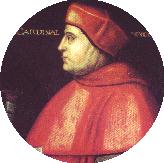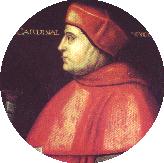
Wolsey, Wolsey Wolsey.
Thomas Wolsey was such an important figure of the Tudor court. In a way, his influence lasted far beyond his death – since he was the one who found and trained Thomas Cromwell.
Wolsey was born around 1473 to an Ipswich butcher. Despite such humble origins, he rose through the Church thanks to his brilliance and dedication (and because his timing was perfect: the young Henry VIII was happy to delegate the day-to-day drudgery involved in the running of the government to someone who could never be a threat). Wolsey began as Henry’s Almoner in 1509, a position that gave him a seat on the Privy Council and therefore visibility – and made him unstoppable. In 1514, he became Archbishop of York, the second highest Ecclesiastic title in the land (behind only the Archbishop of Canterbury). Never one to accept limitations (sees being lifetime appointments), Wolsey got himself named a Cardinal in 1515. This automatically made the highest prelate in England, and it happened in the same year that he became Lord Chancellor. From them on, he sought to convey the image of an alter rex, building Hampton Court Palace, intended to be the finest residence in England, to show foreign embassies that the King’s chief minister “knew how to live as graciously as any cardinal in Rome.” The poet John Skelton wrote the following words, illustrating a bit of the contemporary resentment that Wolsey was overstepping his bounds, that too much of his glory was personal and not reflective of his master:
Why come you not to Court?
To which court?
To the King’s court?
Or to Hampton Court?
Nay, to the King’s court!
The King’s court
Should have the excellence
But Hampton Court
Hath the pre-eminence!
Still, Henry probably would have allowed him to continue like that forever had Wolsey not failed in the one task that mattered: procuring a divorce from Catherine of Aragon. That crime could not be excused. Especially since Wolsey had made the mistake of underestimating Anne Boleyn very early on, earning her undying enmity in 1523 when he broke her engagement to Henry Percy, heir to the Duke of Northumberland. In her he had an implacable enemy.
In 1529 Wolsey was stripped of his government office and property, as well as Hampton Court. He did remain Archbishop of York, and so was sent to Yorkshire to “preach to the sheep.” But even there he was not safe from the rabble-rousers at court. It was decided to accuse him of treason – and Henry Percy, Sixth Duke of Northumberland, was the man sent to arrest him (you know Anne Boleyn arranged for that fillip!) and escort him back to London. Wolsey died on the road – many believe he took poison to avoid being tried and disgraced. Right before his death, he is reputed to have said “If I had served God as diligently as I have done the King, he would not have given me over in my grey hairs.”
Rest in peace.
REFERENCES:
Wikipedia – pages on Thomas Wolsey, Hampton Court Palace.
Historic Royal Palaces – Hampton Court Palace
***
If you like my posts, you’ll love my books! My Seymour Saga trilogy tells the gripping story of the short-lived dynasty that shaped the Tudor Era. Jane the Quene skews romantic, The Path to Somerset is pure Game of Thrones (without the dragons), and The Boy King is a noir coming-of-age. Get them now through Amazon, Barnes & Noble, Kobo, and Apple, or even your local independent bookstore!

(PS Already read them? Did you love them? Then please review them – even just a stars rating! It makes a huge difference in helping new readers find them and would mean the world to me!)


Wolsey was also the ultimate symbol of the new age that was dawning. Until Richard of Gloucester got his come-uppance at Bosworth, the nation was governed by bands of robber barons with fancy titles. When Henry Tudor came to the throne, he was anxious to break the power of the old noble families, and he abolished ‘maintenance’ and ‘livery’ – the keeping of private armies.
But he needed men to assist in the running of the nation, and he had learned from men such as his mother’s Comptroller of Accounts Reynard Bray that the most talented public servants are not necessarily the high born. He therefore began a policy of appointment by merit, and they didn’t come any more talented than Tom Wulcy, a graduate of Oxford at the age of 15. He was followed in turn by the son of a Putney blacksmith and alehouse keeper, Thomas Cromwell, Wolsey’s Secretary once he reached high office at breakneck speed.
But such elevation of the lowly born was anathema to those who felt entitled to rule the nation by the simple qualification of birth, and Thomas Howard, 3rd Duke of Norfolk, was the most resentful of all. He put paid to Wolsey, and then became embroiled in a lifelong feud with Cromwell that did neither of them any good.
But the mold had been broken, and henceforth England would be governed by men of ability and selfless dedication – William Cecil being a prime example in the reign of Elizabeth. The kudos for driving through that change goes to the son of an Ipswich butcher whose obscure and badly marked grave in Leicester was the only remaining epitaph to a prodigiously talented man. The irony was that obscure burial in Leicester had also been the fate of Richard of Gloucester.